
Beetles are insects that form the order Coleoptera, in the superorder Holometabola. Their front pair of wings are hardened into wing-cases, elytra, distinguishing them from most other insects. The Coleoptera, with about 400,000 described species, is the largest of all orders, constituting almost 40% of described insects and 25% of all known animal species; new species are discovered frequently, with estimates suggesting that there are between 0.9 and 2.1 million total species. Found in almost every habitat except the sea and the polar regions, they interact with their ecosystems in several ways: beetles often feed on plants and fungi, break down animal and plant debris, and eat other invertebrates. Some species are serious agricultural pests, such as the Colorado potato beetle, while others such as Coccinellidae eat aphids, scale insects, thrips, and other plant-sucking insects that damage crops.

The family Scarabaeidae, as currently defined, consists of over 35,000 species of beetles worldwide; they are often called scarabs or scarab beetles. The classification of this family has undergone significant change in recent years. Several subfamilies have been elevated to family rank, and some reduced to lower ranks. The subfamilies listed in this article are in accordance with those in Catalog of Life (2023).

Silphidae is a family of beetles that are known commonly as large carrion beetles, carrion beetles or burying beetles. There are two subfamilies: Silphinae and Nicrophorinae. Nicrophorines are sometimes known as sexton beetles. The number of species is relatively small at around two hundred. They are more diverse in the temperate region although a few tropical endemics are known. Both subfamilies feed on decaying organic matter such as dead animals. The subfamilies differ in which uses parental care and which types of carcasses they prefer. Silphidae are considered to be of importance to forensic entomologists because when they are found on a decaying body they are used to help estimate a post-mortem interval.
Dung beetles are beetles that feed on feces. Some species of dung beetles can bury dung 250 times their own mass in one night.

Histeridae is a family of beetles commonly known as clown beetles or hister beetles. This very diverse group of beetles contains 3,900 species found worldwide. They can be easily identified by their shortened elytra that leaves two of the seven tergites exposed, and their geniculate (elbowed) antennae with clubbed ends. These predatory feeders are most active at night and will fake death if they feel threatened. This family of beetles will occupy almost any kind of niche throughout the world. Hister beetles have proved useful during forensic investigations to help in time of death estimation. Also, certain species are used in the control of livestock pests that infest dung and to control houseflies. Because they are predacious and will even eat other hister beetles, they must be isolated when collected.

The scarab beetle subfamily Scarabaeinae consists of species collectively called true dung beetles. Most of the beetles of this subfamily feed exclusively on dung. However, some may feed on decomposing matter including carrion, decaying fruits and fungi. Dung beetles can be placed into three structural guilds based on their method of dung processing namely rollers (telecoprids), dwellers (endocoprids) and tunnelers (paracoprids). Dung removal and burial by dung beetles result in ecological benefits such as soil aeration and fertilization; improved nutrient cycling and uptake by plants, increase in Pasture quality, biological control of pest flies and intestinal parasites and secondary seed dispersal. Well-known members include the genera Scarabaeus and Sisyphus, and Phanaeus vindex.

The genus Scarabaeus consists of a number of Afro-Eurasian dung beetle species, including the "sacred scarab beetle", Scarabaeus sacer and is the namesake of the tribe Scarabaeini, the family Scarabaeidae, the superfamily Scarabaeoidea and the infraorder Scarabaeiformia. These beetles feed exclusively on dung, which they accomplish by rolling a piece of dung some distance from where it was deposited, and burying it in order to feed on it underground. They also prepare food for their larvae by excavating an underground chamber, and filling it with balls that have eggs laid in them. The growing larva feeds upon the dung ball, pupates, and eventually emerges as an adult.

Pachnoda sinuata, the garden fruit chafer or checkers tor or brown-and-yellow fruit chafer, is a species of beetle found in Namibia, South Africa and Egypt.

Nicrophorus orbicollis is a nearctic burying beetle first described by Thomas Say in 1825. It is a member of the genus Nicrophorus or sexton beetles, comprising the most common beetles in the family Silphidae. This species is a decomposer feeding on carcasses of small dead animals. N. orbicollis can be used for scientific research both medically and forensically.

Catharsius is a genus of dung beetles in the tribe Coprini in the scarab family.
The Australian Dung Beetle Project (1965–1985), conceived and led by Dr George Bornemissza of the Commonwealth Scientific and Industrial Research Organisation (CSIRO), was an international scientific research and biological control project with the primary goal to control the polluting effects of cattle dung.

George Francis Bornemissza was a Hungarian-born entomologist and ecologist. He studied science at the University of Budapest before obtaining his Ph.D. in zoology at the University of Innsbruck in Austria in 1950. At the end of that year, he emigrated to Australia. There he first worked in the Department of Zoology at the University of Western Australia for 3 years, before pursuing a career with the Commonwealth Scientific and Industrial Research Organisation (CSIRO). Bornemissza was known for his work on the Australian Dung Beetle Project (1965–1985) while working at CSIRO's Division of Entomology. He wrote scientific papers and books based on his research and contributed a collection of mounted beetle specimens to the Australian National Insect Collection and the Tasmanian Museum and Art Gallery. In 2001 he was awarded the Medal of the Order of Australia for his services to Australian entomology.
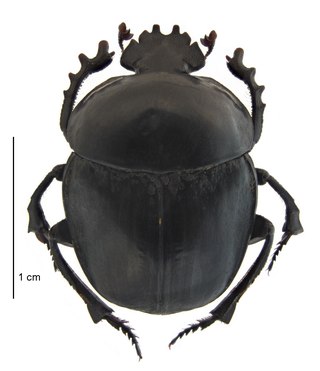
Sceliages, Westwood,, is a sub-genus of the Scarabaeus dung beetles, and are obligate predators of spirostreptid, spirobolid and julid millipedes, having renounced the coprophagy for which they were named. The genus is near-endemic to Southern Africa, Sceliages augias exceptionally ranging as far north as the Democratic Republic of Congo.

Phanaeus, the rainbow scarabs, is a genus of true dung beetles in the family Scarabaeidae, ranging from the United States to northern Argentina, with the highest species richness in Mexico. Depending on species, they can inhabit a wide range of habitats, from tropical to temperate climates and deserts to rainforests. In those living in relatively arid places adults are primarily active during the wet season and those living in relatively cold places are primarily active during the summer. They are excellent diggers and good fliers.
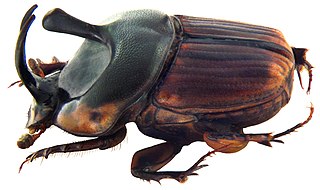
Oniticellini are a tribe of scarab beetles, in the true dung beetle subfamily (Scarabaeinae). Nearly all species of this tribe feed on and nest in dung, mainly that of large herbivores. Most are tunnelers; dung is buried at the ends of tunnels dug below a dropping, and used as food by both adults and larvae; others, known as dwellers make brood cavities within or just beneath the dung.
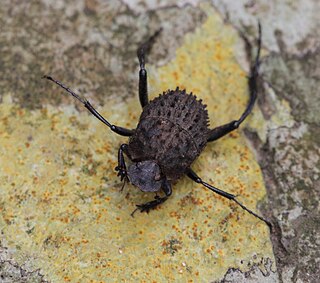
Sisyphini is a tribe of scarab beetles, in the dung beetle subfamily (Scarabaeinae), but it may now be combined with the Scarabaeini. The middle and hind legs are very long; the relatively short body is laterally compressed and has flattened sides. Relative to other dung beetles they are of small to moderate size.
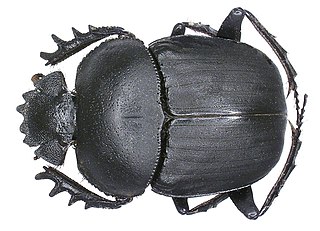
Scarabaeus ambiguus is a species of Old World dung beetles. This beetle rolls up a ball of dung before laying eggs on it and burying it.
Sisyphus crispatus, is a species of dung beetle found in India, Sri Lanka and Pakistan.
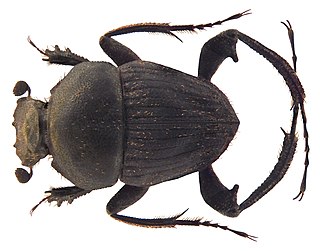
Sisyphus indicus, is a species of dung beetle found in India, Nepal and Sri Lanka.

Sisyphus longipes, is a species of dung beetle found in India, Sri Lanka, Nepal, Myanmar and Thailand.

















